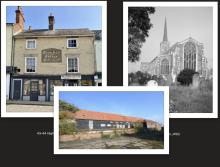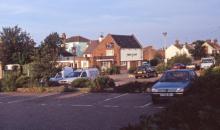1800s

In some ways, buildings are every bit as much historical documents as written sources and can inform the observer of many aspects of human activity in days gone by. Where they have survived in original form, they have much to say of former economic and social conditions – be they domestic, ecclesiastical or industrial in nature. And, if altered and converted at different times, there is just as much to be learned from them. Let us take three of Lowestoft’s buildings, covering these three categories, and consider each one of them in turn within its context.
Added: 18 September, 2025
The type of agriculture practised in Lowestoft during the Early Modern era was of mixed variety, as was the case with most other communities in lowland England. And it was not only mixed in combining crops and livestock; it was also mixed in the sense that many of the people who farmed the land had other interests. It is unfortunate that the two key documents which reveal so much about conduct of agriculture in the parish stand in isolation from each other.
Added: 6 September, 2025
Cattle
The amount of grassland of one kind or another revealed in the 1618 Manor Roll (about 170 acres), when compared with that discernible in the 18thcentury Tithe Accounts (about sixty-five acres of permanent pasture, or meadow, and an annual average of twenty-eight acres of the sown variety) may appear to suggest that fewer cattle were being kept in the parish by 1700 than had been the case one hundred years before.
Added: 2 September, 2025
It is unarguable that maritime influences were the major factor in shaping Lowestoft during the Late Medieval and Early Modern periods. Yet, agriculture was also an important element in the development of the town, creating employment for a number of the inhabitants (and limited wealth for a few) and leading to a number of associated trades and occupations. It also acted as a safety-net for the community, something that was always there as part of the economic structure – something that could, in periods of adversity, provide subsistence until better times returned.
Added: 23 August, 2025
Grain
The potential value of Tithe Accounts books as a source of information regarding historical agricultural practice has long been recognised. The surviving Lowestoft tithe records (Norfolk Record Office, PD 589/80) begin to record details of agriculture in the parish in the year 1698, but there is no reference to the growing of corn until 1749 – the year in which the Rev. John Tanner began to draw the rectorial tithes.
Added: 18 August, 2025
The Novel David Copperfield is well known for its central figure’s connection with Blundeston, Great Yarmouth and the Peggotty family – but, scarcely known at all for David’s brief acquaintance with the town of Lowestoft, as revealed in Chapter 2 of the novel.
Added: 10 February, 2025
Centuries of Ongoing Change
Denmark Road, Flensburgh Street and Tonning Street: three closely connected roads near the shopping-centre and railway station of the Suffolk coastal town of Lowestoft (the UK’s most easterly community). What possible connection can there be between this trio, the most southerly located of the Scandinavian countries and two towns in the German state of Schleswig-Holstein?
Added: 16 December, 2024
May 1535 - Muster Roll of Lothingland Half-hundred, dated 23rd of the month, listed and named 292 able-bodied men for its defence. Lowestoft provided 130 of these (46%), with three widows included for their late husbands’ weapons. Armaments consisted mainly of bills (a hatchet-like metal attachment on the end of a pole) and bows and arrows, with a minority of the men also possessing helmets and body armour. No firearms are recorded.
Added: 14 April, 2024
The collection of superstitions which follows is not seen, in any way, as definitive. It simply records a number of the more commonly held beliefs once current in East Anglian fishing communities. Not all of them were peculiar to fishermen only; some had (and may still have) currency among seafarers in general, while others can be traced well inland. But no matter how extensive their area of circulation, all of them are interesting for what they tell us of the human mind and the way it works when faced with natural powers beyond either its understanding or its control.
Added: 23 February, 2024This building, which stands in Arnold Street, is in need of some restorative tlc and is an important remnant of Lowestoft’s military past.
Added: 22 September, 2023